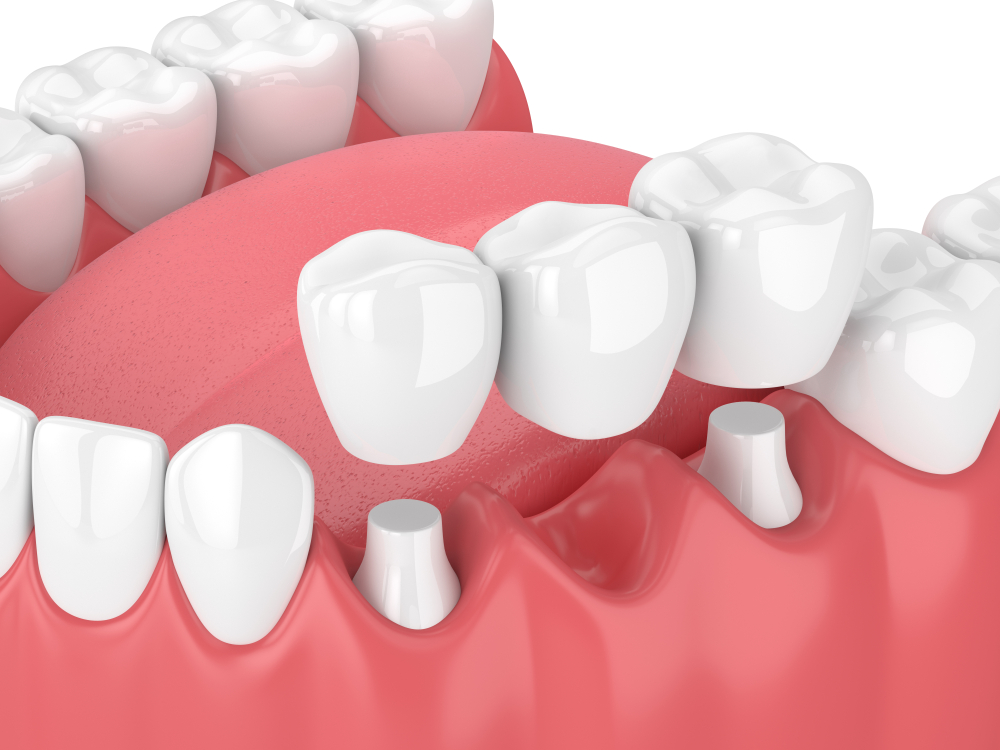Bridges

Dental bridges are a common dental restoration used to replace missing teeth and restore the functionality and aesthetics of the smile. Whether you have lost a tooth due to injury, decay, or gum disease, dental bridges offer a permanent solution that helps maintain oral health. For a better understanding of dental bridges and their importance in dental care, count on the professionals at Amedeo and Colonna, LTD in Park Ridge.
Understanding Dental Bridges
A dental bridge, also called a fixed bridge, is used to replace missing teeth. It consists of abutment teeth and a pontic. The abutment teeth are natural or implant-supported teeth on either side of the gap. The pontic, an artificial tooth, fills the gap and restores the alignment of the teeth. There are different types of bridges for specific needs.
Dental bridges aim to provide a natural-looking tooth replacement that improves oral function and enhances the smile’s appearance. They prevent oral health issues, maintain tooth integrity, and improve the quality of life for individuals with tooth loss.
The Need for Dental Bridges
When a tooth is lost, it’s important to address the gap. Missing teeth affect both the appearance and oral health. Adjacent teeth may shift and cause bite problems. Gum disease and tooth decay are more likely in areas without teeth as oral hygiene becomes more difficult. Dental bridges fill the gap and prevent neighboring teeth from shifting. They restore proper alignment, maintain natural teeth integrity, and promote oral function. Bridges also support facial structure, preventing a sunken appearance caused by missing teeth.
Different Types of Dental Bridges
Dental bridges come in different types, each offering unique benefits and catering to specific dental conditions. The main types of dental bridges include traditional fixed bridges, cantilever bridges, Maryland bonded bridges, and implant-supported bridges. Traditional Fixed Bridges
Traditional fixed bridges
Traditional fixed bridges are the most common type of bridge and are utilized when natural teeth flank the gap left by the missing tooth. Amedeo and Colonna, LTD prepare the abutment teeth by removing some enamel to facilitate the dental crown, which anchors the artificial tooth in place.
This time-tested solution effectively restores both functionality and aesthetics. Patients’ oral hygiene significantly impacts the bridge’s lifespan, emphasizing the need for good dental care. During fitting, temporary cement ensures proper placement before permanent cementation.
Cantilever Bridges
Cantilever bridges are a type of dental bridge that is typically used when there are adjacent teeth on only one side of the gap. However, it’s important to note that this design places more stress on the abutment tooth. Amedeo and Colonna, LTD take great care to ensure that the neighboring teeth are healthy and can withstand the additional pressure placed on them by the bridge.
Due to their design, cantilever bridges are best suited for use in the front of the mouth where chewing forces are lighter. If you are considering getting a dental bridge, Amedeo and Colonna, LTD will help you determine which type is best for your individual needs and circumstances.
Maryland Bonded Bridges
Maryland bonded bridges are a conservative option for those seeking an alternative to traditional bridges. Unlike conventional bridges, this type of bridge requires minimal preparation of adjacent teeth. The metal wings of the bridge are discreetly attached to the back of adjacent teeth, especially for front teeth, which restores the natural appearance of your smile.
This procedure is also known as a resin-bonded bridge or a Maryland bridge and is a popular choice for those looking for an aesthetic solution to missing teeth. However, it is important to note that Maryland bonded bridges may not be suitable for everyone and should be evaluated by the professionals at Amedeo and Colonna, LTD.
Implant-Supported Bridges
Implant-supported bridges are an excellent solution for individuals with missing teeth, offering a secure and long-lasting alternative to traditional bridges. Dental implants form the foundation of these bridges, providing essential support without affecting adjacent natural teeth. However, patients considering this option must have healthy gums and sufficient bone to support the implants.
The custom-made artificial teeth blend seamlessly with natural teeth, allowing for a harmonious smile that is both aesthetically pleasing and functional. Implant-supported bridges can drastically improve an individual’s quality of life by restoring their ability to chew and speak with confidence.
Additionally, they are easy to maintain and care for, making them a convenient option for those seeking a permanent tooth replacement solution.
The Procedure for Getting a Dental Bridge
Getting a dental bridge involves several steps. Amedeo and Colonna, LTD prepare the abutment teeth by removing enamel. Impressions are taken to create a model for the artificial tooth and crowns. A temporary bridge is placed while the customized bridge is being made. The new bridge is then checked for fit, adjusted if needed, and cemented in place.
Preparation for Dental Bridge Procedure
Before the dental bridge procedure, a discussion with the experts at Amedeo and Colonna, LTD will determine the suitable type of bridge for the patient’s specific needs. Local anesthesia may be used for comfort during tooth preparation. Impressions of the teeth are taken to create a custom-fit bridge, matching natural teeth in color, shape, and size. Patients should be informed about the temporary nature of the bridge placement and the subsequent permanent placement. The bridge is attached using dental cement, ensuring a secure and stable artificial tooth.
The Process of Dental Bridge Placement
Dental bridge placement starts with preparing the abutment teeth, followed by the potential placement of a temporary bridge. This procedure includes setting an artificial tooth or pontic and preparing the neighboring teeth for dental crowns. Ultimately, the most common type of bridge is affixed using dental cement.
Advantages of Dental Bridges
Maintaining good oral hygiene, dental bridges stand as a pioneering force in restoring missing teeth. They offer a conservative alternative to dental implants and are the most common type of bridge used at Amedeo and Colonna, LTD. Whether it’s traditional, cantilever, or Maryland bridges, they effectively fill the gap between teeth without the need for invasive procedures.
Dental bridges also support the placement of dental crowns, functioning as an artificial tooth.
Cleaning and Caring for Your Dental Bridge
Proper maintenance of an artificial tooth like a dental bridge involves using specialized dental floss or interdental brushes for cleaning. Regular removal of plaque and food debris from the bridge is crucial for its care. Additionally, non-abrasive toothpaste and oral rinses should be used to maintain the dental crown.
Commitment to good oral hygiene practices, as recommended by the American Dental Association, is essential for long-term bridge maintenance. Regular dental visits at Amedeo and Colonna, LTD are necessary for professional assessment and cleaning of the most common type of bridge.
Replacement and Repair of Dental Bridges
When dental bridges show signs of wear or damage, replacing them becomes necessary. The replacement process involves the removal of the existing bridge and the placement of a new artificial tooth. On the other hand, repairing a dental bridge may involve fixing a broken dental crown or addressing issues with the framework.
It’s essential to consult with the professionals at Amedeo and Colonna, LTD for the most common type of bridge repair or replacement, depending on the condition.
Dental Bridge Vs. Dental Implant
When choosing between a dental bridge and a dental implant, understanding the different types of dental bridges is crucial for making an informed decision. The number of missing teeth and the type of bridge play a significant role in determining whether a bridge or implant is the better option.
Dental implants provide a more conservative alternative to traditional bridges and may be more suitable depending on the type of bridge and the condition of the adjacent teeth. Additionally, a dental bridge is often a good choice for replacing a missing tooth at the front of the mouth.
Schedule a consultation today
Dental bridges play a crucial role in restoring the function and aesthetics of your smile. They are versatile and can be customized to fit your specific dental needs. Whether you opt for traditional fixed bridges, cantilever bridges, Maryland bonded bridges, or implant-supported bridges, it is important to weigh their pros and cons before making a decision.
Additionally, proper care and maintenance are essential for the longevity of your dental bridge. Regular dental check-ups and practicing good oral hygiene habits will help ensure the success of your dental bridge.
If you are considering a dental bridge or have any concerns about your oral health, consult with the professionals at Amedeo and Colonna, LTD in Park Ridge, today.

 Dr. Colonna
Dr. Colonna Dr. Maloney
Dr. Maloney Meet the Team
Meet the Team



